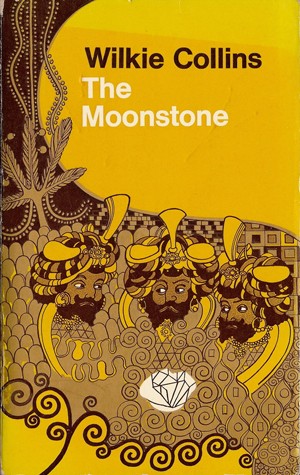
The Moonstone of the title is a large yellow diamond sacred to Hindus living under the British Raj. It has been acquired in rather brutal circumstances by British Army officer John Herncastle. Rachel Verinder inherits this diamond from her uncle on her 18th birthday. However, many believe that the gemstone is cursed and their fears seem justified when the diamond disappears from a locked cupboard in Rachel’s bedroom. The famed and authoritative Sergeant Cuff is brought in to find the thief and the precious stone. However, it will take more than a year and several narrators to discover the truth.
An 1882 American serialisation of the book.
Read it fast
It is still a page-turner today, even though our attention spans have shortened and the crime committed is merely theft, rather than murder. It’s a book which demands to be read quite quickly, especially since there are so many small details to remember. The well-versed modern reader of crime will know that each detail could be important and there is plenty of foreshadowing of that. However, red herrings are also liberally sprinkled throughout the story, and Collins keeps you on your toes.
One of the most interesting literary devices employed by Wilkie Collins is the handing of the baton from one narrator to another. Not only does each character’s partial and biased point of view add to the complexity of the story, but each witness statement is hugely revealing of character, from the faithful and fussy older servant Gabriel Betteridge to the incorrigibly sanctimonious Miss Clack. This stylistic device seems to be gaining in popularity once more, and many psychological thrillers of recent years rely on the interplay of two or three narrative voices. Collins is more ambitious, with no less than six narrators, and he manages to keep their voices distinct and instantly recognisable.
Greg Wise and Keeley Hawkes as Franklin Blake and Rachel Verinder in a 1996 TV production.
One of the things that will strike when you re-read The Moonstone is how progressive it is regarding social attitudes. Rachel Verinder is an heiress with a mind of her own and her mother has no qualms in disagreeing with Sergeant Cuff on occasion. Rosanna Spearman, a servant girl with the crooked shoulder and dodgy past, is presented with great compassion, and the author condemns the other servants’ snobbish attitude towards her. The forlorn and lonely doctor addicted to opium is one of the nicest characters in the book. The description of the moonstone in its Indian setting and its forcible acquisition is critical of colonial plundering. Finally, through Miss Clack and the philanthropist Godfrey Ablewhite, and their preposterously named charity Mothers’ Small Clothes Conversion Society, Collins pokes fun at religious hypocrisy as well.
The novel has been filmed and adapted in all sorts of ways. The best film version you’re likely to see is the 1934 American production directed by Reginald Baker, even though budget constraints meant that large parts of the story were left out. In1959, the BBC adapted it for television, and in 1972 there was a remake. Many fans are happy with the 1996 production done by the BBC, Carlton Television and the US channel WGBH, though there are some significant changes to the story. There has also been a computer game for Mac and PC based on the book. Mystery Masterpiece: The Moonstone is more of a hidden object game and although it has some mystery elements to it, again the original premise is stretched.
Perhaps this will finally be the year of an adaptation worthy of the original. A full five years after it was first commissioned by the BBC, a new five-part daytime drama series is scheduled for later this year as part of the Love to Read season. Details are sparse, but we do know that John Thomson will play the legendary Sergeant Cuff and Sarah Hadland plays Miss Clack. We don’t know when it will be broadcast, but when it is it will be over five consecutive days, during the daytime. Filming began in Yorkshire in July 2016.
Classics in September 2016 is sponsored by Bloomsbury Reader.